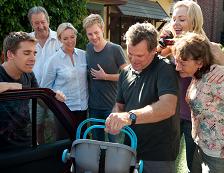On location: Packed to the Rafters – a familiar feeling
 Now entering its third year, Packed to the Rafters has become the Seven Network’s flagship drama. Its creators told Eleeza Hooker that making a hit TV show might be difficult, but maintaining it over the years is even harder.
Now entering its third year, Packed to the Rafters has become the Seven Network’s flagship drama. Its creators told Eleeza Hooker that making a hit TV show might be difficult, but maintaining it over the years is even harder.
The series, about a couple whose adult children come back to live at the family home, has been a hit with audiences, averaging 1.9m viewers in 2008 and 2009 – with a peak of 2.07m for Episode 41, a number surpassed only by Nine’s Underbelly.
The concept was developed by series creator and network script executive Bevan Lee, producer Jo Porter and script producer Anthony Ellis. Together, they’re in charge of keeping the series going.
“It’s a nice problem to have to maintain a hit show. As you keep going through stories, it becomes harder and harder,” said Porter.
According to Porter, Rafters is a valuable property for the network, and one that needs to be attended to if Seven wants to retain its healthy audience share.
“Everybody [at Seven] is very protective [of Rafters] and wants to see it continue and to do well for them.”
In Porter’s opinion, changing the format too much is a big mistake that often happens in the television industry – “sometimes as the creator you get bored with it and want to tweak it” – leaving audiences wondering what the show is about. Change, while necessary, must be subtle.
At the end of the second series, forty-something Julie (Rebecca Gibney) and Dave (Erik Thomson) had a baby they called Ruby. This new Rafter is the driving force of the series, as the family adapts to a new lifestyle.
“There are obvious changes; having to deal with the baby and her demands – feeding, bathing, staying up all night, etc.” explained Porter. “It will also make the other characters look at the possibility of babies themselves.”
SAME FAMILY, NEW HOME
Each series of Rafters features 22×60 min episodes, which are shot in blocks of two over 12 days. The first two years, Rafters was shot at Seven’s Epping studios in Sydney. Earlier this year, the network relocated Rafters and Home and Away from Epping to a new facility in Eveleigh, at the Australian Technology Park.
The move has been beneficial. The main home set was originally conceived by production designer Samuel Rickard to be one piece – from the front door through to the back door. Due to the limited size of the Epping studios, that was impossible to achieve and the sets had to be spread across three different studios. Their new home – which Porter says is “enormous” – has allowed the production to finally assemble the main house as one piece. The move increased the total number of sets that can stand at the same time.
Other benefits, in addition to an easier commute for cast and crew, said Porter, include easier scheduling and more lighting possibilities.
The first three years, Rafters has had a core group of four to five writers (including Jeff Truman, Marieke Hardy, Abe Pogos, Margaret Wilson, Tony Mophett, Chris McCourt, Rick Held, Jenny Lewis, Trent Roberts, Boaz Stark, Nick Stevens, Chris Hawshaw and Martin McKenna), but Ellis says he’s looking at expanding the team to eight for the fourth series.
The two-draft writing process starts with a meeting between Lee, Ellis, the staff script editors and the writer of the episode, to discuss the general plot. The writer then works on a scene breakdown for the episode and, after receiving feedback from the rest of the team, writes two drafts which are then handed over to the in-house script editors to ensure character and style consistency.
“The in-house writers are the best at that because external writers are working on other projects. Internal writers have a much stronger sense of the big picture, the totality of the show.
“We are careful not to let slip any continuity mistakes; it’s amazing how vigilant viewers are, they will always pick up continuity glitches,” explained Ellis.


Just trying to find out the name of the hotel that Dave and Julie stayed in during the last episode., can you steer me in the right direction
tks
the Kent hotel is what they called it